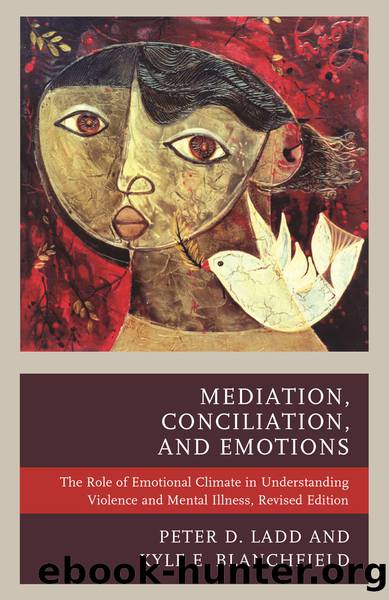Mediation, Conciliation, and Emotions by Ladd Peter D.;Blanchfield Kyle E.; & Kyle E. Blanchfield

Author:Ladd, Peter D.;Blanchfield, Kyle E.; & Kyle E. Blanchfield
Language: eng
Format: epub
ISBN: 4503940
Publisher: Lexington Books/Fortress Academic
Chapter 7
Guilt and Conciliation
In this chapter, we explore the phenomenon of guilt, and how it can become an identity problem for those who accept the shame associated with feeling guilty. Guilt also can turn into a mental health problem especially when guilt is confused with sadness. This happens when it becomes a negative emotional reaction instead of an emotion that is a natural part of healing. For example, when a loved one dies, the attachment to that person may cause others to experience acute sadness. Sadness becomes a part of healing, and is beneficial with people who grieve. However, when sadness turns to guilt, the grieving process is interrupted. A person or the climate surrounding grieving people is filled with making judgments and placing blame. From a conciliation point of view, it may take a conciliator to help grieving people understand the difference between guilt and sadness. Clarification of this difference can be an effective resolution by those who experience grief. However, if left alone guilt may turn to depressionâcausing mental health problems.
Another example of the phenomenon of guilt comes from numerous religions around the world. For example, the Catholic Church has the experience of guilt within its core beliefs. From Original Sin to not following the New Testament, the church deals with unacceptable behavior through guilt, when practitioners do not follow the laws of Jesus. However, the Catholic Church also practices reconciliation through the rituals of Confession and saying the Rosary. For many, this experience with guilt does not rise to the level of a conflict. Guilt becomes fallout from not practicing spiritual beliefs based on faith.
Some people in our society use guilt as a form of victimizationânot by others but by oneâs self. In addiction recovery, guilt can be used to justify avoiding growth and change. Some may say, âI cannot risk changing my life because I am an alcoholic.â âI never do anything right.â In these statements, we see people who are not afraid of failure but fear success. Unfortunately for the people surrounding a guilty person, a climate of guilt may form where others begin lacking motivation for growth and change.
In our case study, we start the chapter with alcoholics who are practicing self-victimization. This is followed by alcoholic mentors who practice the art of âguilt trippingâ in order to control an Alcohol Anonymous support group. The case study requires a conciliator to create a climate of respect to counteract guilt. When guilt is used against others it walks a fine line between emotion and judgment. âGuilt trippingâ others, forms a judgment that others are doing something wrong. An emotional climate of guilt is filled with strong emotions but also a myriad of judgments and peer pressure. Personal guilt is a subtle emotion that can be devastating anytime a climate of guilt fills the air.
Case Study
Michael moved to Boston only a short while ago and was already searching for a group meeting that would address his alcohol problem. He had been a recovering alcoholic for eleven years and had a keen realization of how important these meetings were in turning his life around.
Download
This site does not store any files on its server. We only index and link to content provided by other sites. Please contact the content providers to delete copyright contents if any and email us, we'll remove relevant links or contents immediately.
Hollow Courts (2022) by Unknown(250)
The Crisis in America's Criminal Courts by William R. Kelly(240)
Mediation, Conciliation, and Emotions by Ladd Peter D.;Blanchfield Kyle E.; & Kyle E. Blanchfield(172)
I Dissent : Great Opposing Opinions in Landmark Supreme Court Cases by Mark Tushnet(169)
Settling Disputes by Linda Singer(161)
Equity and Gender by Ellen Frankel Paul(160)
A Lawyer in Indian Country by Alvin J. Ziontz(155)
The Puzzle of Unanimity by Corley Pamela C.;Steigerwalt Amy;Ward Artemus;(146)
The Nominee by Alan P. Woodruff(145)
How to Master Commercial Mediation by Richbell David;(144)
Judge and Jury by WILLIAM BERNHARDT(140)
Public Actors in International Investment Law by Catharine Titi(134)
Madam Chief Justice by W. Lewis Burke Joan P. Assey(133)
In Defense of the Constitution by George W. Carey(133)
War Crimes and the Culture of Peace by Louise Arbour(128)
Law, Courts, and Justice in America by Howard Abadinsky(126)
The National Security Court System by Sulmasy Glenn;(122)
The Trial and Execution of Mark and Phillis, Slaves of Capt. John Codman by Abner Cheney Goodell(119)
Kaleidoscope by Alan P. Woodruff(114)
